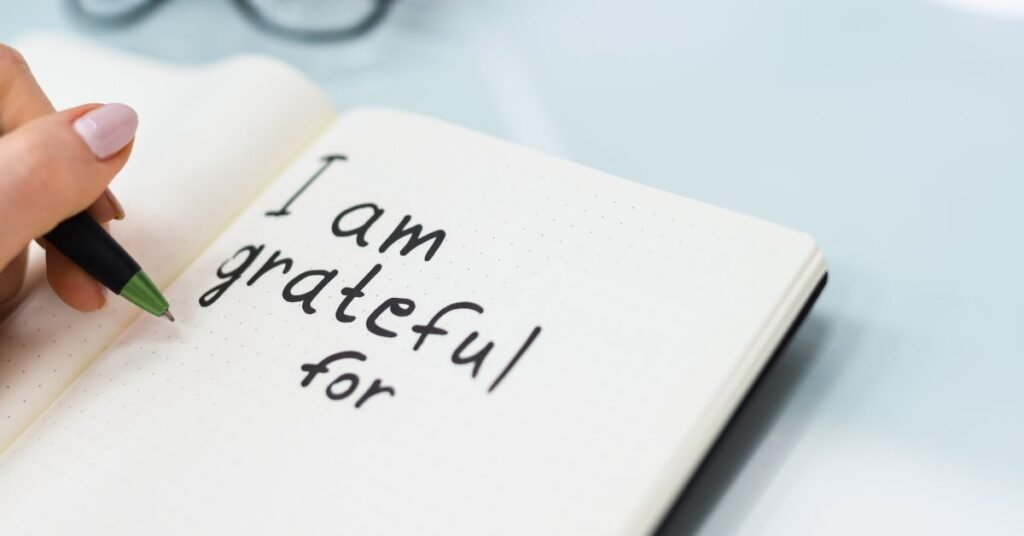Introduction: Why Your Brain Needs Gratitude Training
In our fast-paced, achievement-oriented society, we’ve become experts at spotting what’s wrong. Our minds naturally gravitate toward problems, deficiencies, and unfinished business. This negativity bias, while evolutionarily protective, can trap us in cycles of dissatisfaction and stress.
But what if there was a scientifically-proven method to retrain your brain for positivity? What if a simple daily practice could literally rewire your neural pathways to notice abundance instead of scarcity, joy instead of worry?
That practice exists, and it’s called gratitude. Far from being mere positive thinking, gratitude is a powerful neuroplasticity tool that can transform your mental landscape, improve your physical health, and enhance your relationships.
This comprehensive guide explores the fascinating science behind gratitude, its profound benefits, and practical strategies to make it a transformative part of your daily life.
Table of Contents

The Neuroscience Behind Gratitude
How Gratitude Changes Your Brain
Recent advances in neuroscience have revealed exactly what happens in your brain when you practice gratitude. Using functional magnetic resonance imaging (fMRI), researchers have discovered that gratitude activates multiple brain regions simultaneously:
The Prefrontal Cortex: The brain’s executive center lights up during gratitude practice, enhancing decision-making and emotional regulation.
The Anterior Cingulate Cortex: This region, crucial for empathy and social connection, shows increased activity in grateful individuals.
The Dopamine Pathways: Gratitude triggers the release of dopamine, the neurotransmitter associated with pleasure and motivation, creating a natural “reward” for positive thinking.
The Serotonin System: Regular gratitude practice increases serotonin production, contributing to improved mood and emotional stability.
The Neuroplasticity Effect
Dr. Rick Hanson, neuropsychologist and author of “Hardwiring Happiness,” explains that gratitude practice literally changes brain structure. Through neuroplasticity—the brain’s ability to reorganize itself—consistent gratitude exercises strengthen neural pathways associated with positive emotions while weakening those linked to negativity and stress.
This isn’t just temporary mood enhancement; it’s permanent brain remodeling. Studies show that people who practice gratitude for just eight weeks demonstrate measurable changes in brain structure, with increased gray matter in areas associated with learning, memory, and emotional regulation.
The Gratitude-Stress Connection
Research from UCLA’s Mindfulness Research Center reveals that gratitude practice significantly reduces cortisol levels—the primary stress hormone. When cortisol decreases, your entire physiological system benefits: blood pressure drops, immune function improves, and inflammation markers decrease.
The Comprehensive Benefits of Gratitude Practice
Mental Health Transformation
Depression and Anxiety Reduction: A landmark study published in the Journal of Personality and Social Psychology found that participants who wrote gratitude letters showed significant improvements in depression symptoms that lasted up to three months.
Enhanced Emotional Resilience: Grateful individuals demonstrate greater ability to bounce back from trauma and adversity. They reframe negative experiences more quickly and maintain hope during difficult periods.
Improved Self-Esteem: Gratitude practice reduces social comparisons and increases self-acceptance. Instead of feeling envious of others’ successes, grateful people celebrate them.
Physical Health Benefits
Better Sleep Quality: Studies show that people who practice gratitude fall asleep faster, sleep more deeply, and wake up more refreshed. The practice calms the nervous system and reduces racing thoughts that interfere with rest.
Stronger Immune System: Grateful individuals have higher levels of immunoglobulin A, an antibody that plays a crucial role in immune function. They also report fewer symptoms of illness and recover faster when they do get sick.
Cardiovascular Health: Gratitude practice is associated with lower blood pressure, reduced inflammation, and improved heart rate variability—all markers of cardiovascular wellness.
Pain Management: Research indicates that grateful people experience less chronic pain and have higher pain tolerance. The practice appears to modulate pain perception through endorphin release.
Social and Relationship Enhancement
Deeper Connections: Expressing gratitude strengthens relationships by increasing feelings of closeness and mutual appreciation. It creates positive feedback loops that enhance relationship satisfaction.
Increased Prosocial Behavior: Grateful people are more likely to help others, volunteer, and engage in community activities. They demonstrate greater empathy and compassion.
Better Communication: Gratitude practice improves emotional intelligence and communication skills, leading to more effective conflict resolution and deeper understanding.
Professional and Academic Performance
Enhanced Focus and Productivity: Grateful individuals show improved attention span and cognitive flexibility. They’re better at problem-solving and creative thinking.
Leadership Effectiveness: Managers who express gratitude have more engaged teams, lower turnover rates, and better overall performance metrics.
Academic Achievement: Students who practice gratitude demonstrate improved grades, better attendance, and increased motivation to learn.

Evidence-Based Gratitude Practices
The Classic Gratitude Journal
The Method: Each evening, write down three to five specific things you’re grateful for. Include details about why each item matters to you and how it made you feel.
Scientific Backing: Dr. Robert Emmons’ research at UC Davis shows that people who keep gratitude journals exercise more regularly, report fewer physical symptoms, feel better about their lives, and are more optimistic about the future.
Advanced Technique: Instead of just listing items, write a brief story about each gratitude entry. This narrative approach engages more brain regions and creates stronger neural pathways.
The Gratitude Letter Practice
The Method: Once a week, write a detailed letter to someone who has positively impacted your life. Be specific about what they did and how it affected you. You can choose to send it or keep it private.
Research Results: Dr. Martin Seligman’s studies show that people who write and deliver gratitude letters experience immediate increases in happiness that can last up to three months.
Variation: Create a “gratitude video message” for the digital age. Record yourself expressing appreciation and share it with the recipient.
Mindful Gratitude Meditation
The Practice: Spend 10-15 minutes in quiet reflection, bringing to mind people, experiences, or aspects of your life you appreciate. Focus on the physical sensations of gratitude in your body.
Neuroscience Insight: This practice combines the benefits of meditation (increased gray matter, reduced amygdala reactivity) with gratitude’s positive effects, creating a powerful synergy for brain health.
Guided Approach: Start with your breath, then expand to your body, your immediate environment, your relationships, and finally your life circumstances.
The Gratitude Photo Challenge
Modern Approach: Take one photo daily of something you’re grateful for. Write a brief caption explaining your appreciation. This visual practice engages different brain regions and creates lasting memories.
Social Benefits: Sharing gratitude photos on social media can inspire others and create positive community interactions.
Gratitude in Difficult Times
The Challenge: Finding gratitude during hardship, loss, or trauma requires a nuanced approach that doesn’t minimize genuine pain.
The Method: Focus on small, immediate comforts (a warm cup of tea, a friend’s text message, a moment of peace) rather than trying to be grateful for the difficult situation itself.
Research Support: Studies show that people who can find small moments of gratitude during adversity recover faster and experience post-traumatic growth.

Overcoming Common Obstacles
“I Can’t Think of Anything”
The Solution: Start with the most basic elements of life. You’re breathing, you have shelter, you can read this article. Begin with survival needs and gradually expand to more specific appreciations.
The Gratitude Hierarchy:
1.Basic needs (air, water, shelter)
2.Physical abilities (sight, hearing, movement)
3.Relationships (family, friends, pets)
4.Experiences (memories, learning, growth)
5.Future possibilities (hopes, dreams, potential)
“It Feels Forced or Fake”
Understanding: This is normal and temporary. Like any new skill, gratitude practice feels awkward initially. The key is consistency, not perfection.
The Approach: Start with genuine, small appreciations rather than forcing gratitude for major life events. Authenticity matters more than magnitude.
“I Keep Forgetting”
Habit Stacking: Attach gratitude practice to an existing habit. For example: “After I brush my teeth at night, I’ll write three gratitudes.”
Environmental Cues: Place visual reminders in your environment—a gratitude journal by your bedside, a phone reminder, or a gratitude app.
The Two-Minute Rule: Start with just two minutes daily. Consistency trumps duration in building lasting habits.
“My Life is Too Difficult Right Now”
Trauma-Informed Approach: Gratitude practice during severe hardship requires gentleness and professional support when needed. It’s not about denying pain but finding small islands of stability.
Micro-Gratitudes: Focus on tiny moments—a sip of water when thirsty, a moment of warmth, a brief absence of pain. These small acknowledgments can provide crucial emotional anchoring.
Cultural and Global Perspectives on Gratitude
Eastern Philosophy and Gratitude
Buddhist Tradition: The concept of “mudita” (sympathetic joy) emphasizes gratitude for others’ happiness and success, reducing envy and increasing compassion.
Hindu Practice: “Kritajna” represents deep appreciation for life’s gifts and the interconnectedness of all beings.
Japanese Concept: “Kansha” goes beyond gratitude to include a sense of responsibility and reciprocity for what we receive.
Indigenous Wisdom
Many indigenous cultures have built-in gratitude practices that modern science is now validating:
Native American Traditions: Daily acknowledgment of the four directions, the earth, and all living beings creates a constant state of appreciation.
Aboriginal Australian Practices: Connection to country and ancestral wisdom through gratitude ceremonies that strengthen community bonds.
Modern Global Research
Cross-Cultural Studies: Research across 26 countries shows that gratitude is universally associated with well-being, though expression methods vary culturally.
Collectivist vs. Individualist Societies: Gratitude practices in collectivist cultures often focus on community and family, while individualist cultures emphasize personal growth and achievement.
Gratitude in Specific Life Contexts
Gratitude in Parenting
Teaching Children: Model gratitude behavior, create family gratitude rituals, and help children identify specific reasons for appreciation rather than generic “thank yous.”
Research Findings: Children who practice gratitude show improved academic performance, better social relationships, and increased life satisfaction.
Workplace Gratitude
Leadership Applications: Managers who regularly express specific appreciation see increased employee engagement, reduced turnover, and improved team performance.
Peer Recognition: Horizontal gratitude (between colleagues) creates more positive work environments and increases job satisfaction.
Gratitude in Healthcare
Patient Outcomes: Grateful patients experience less pain, recover faster, and have better relationships with healthcare providers.
Healthcare Provider Benefits: Medical professionals who practice gratitude experience less burnout and greater job satisfaction.
Gratitude and Aging
Cognitive Protection: Older adults who practice gratitude show slower cognitive decline and better memory function.
Social Connection: Gratitude helps combat loneliness and isolation common in aging populations.

The Future of Gratitude Research
Emerging Technologies
Virtual Reality Gratitude: Researchers are exploring VR environments that enhance gratitude experiences through immersive nature scenes and guided practices.
Biofeedback Integration: New devices can measure physiological responses to gratitude practice, providing real-time feedback for optimization.
AI-Powered Personalization: Machine learning algorithms are being developed to customize gratitude practices based on individual personality types and life circumstances.
Genetic and Epigenetic Research
Gratitude Genes: Scientists are investigating whether genetic variations influence gratitude capacity and how practice might affect gene expression.
Intergenerational Effects: Research suggests that gratitude practice might influence epigenetic markers that can be passed to future generations.
Clinical Applications
Therapeutic Protocols: Standardized gratitude interventions are being developed for specific mental health conditions, including PTSD, depression, and anxiety disorders.
Preventive Medicine: Healthcare systems are exploring gratitude practices as preventive interventions for stress-related illnesses.
Your Gratitude Journey Starts Now
The science is clear: gratitude is not just a feel-good practice—it’s a powerful tool for brain health, emotional well-being, and life satisfaction. The research spanning neuroscience, psychology, and medicine consistently shows that regular gratitude practice creates measurable, lasting changes in both brain structure and life experience.
But knowledge without action remains merely interesting information. The transformation happens when you commit to consistent practice, even when it feels awkward or forced initially. Your brain’s neuroplasticity means that every moment of genuine appreciation is literally rewiring your neural networks for greater happiness and resilience.
Start small. Choose one practice from this guide and commit to it for just two weeks. Notice the subtle shifts in your perspective, your relationships, and your overall sense of well-being. Remember, you’re not just changing your thoughts—you’re changing your brain.
The journey of gratitude is ultimately a journey toward a more fulfilling, connected, and meaningful life. In a world that often emphasizes what’s lacking, choosing to focus on abundance is both a radical act and a profound gift to yourself and others.
What will you choose to appreciate today?
Enjoyed this content? Read more on our website.
References and Further Reading
Emmons, R. A., & McCullough, M. E. (2003). Counting blessings versus burdens: An experimental investigation of gratitude and subjective well-being in daily life. Journal of Personality and Social Psychology, 84(2), 377-389.
Seligman, M. E., Steen, T. A., Park, N., & Peterson, C. (2005). Positive psychology progress: Empirical validation of interventions. American Psychologist, 60(5), 410-421.
Kini, P., Wong, J., McInnis, S., Gabana, N., & Brown, J. W. (2016). The effects of gratitude expression on neural activity. NeuroImage, 128, 1-10.
Hanson, R. (2013). Hardwiring Happiness: The New Brain Science of Contentment, Calm, and Confidence. Harmony Books.
Wood, A. M., Froh, J. J., & Geraghty, A. W. (2010). Gratitude and well-being: A review and theoretical integration. Clinical Psychology Review, 30(7), 890-905.
Watkins, P. C., Woodward, K., Stone, T., & Kolts, R. L. (2003). Gratitude and happiness: Development of a measure of gratitude, and relationships with subjective well-being. Clinical Psychology Review, 23(2), 249-266.
Algoe, S. B., & Haidt, J. (2009). Witnessing excellence in action: The ‘other-praising’ emotions of elevation, gratitude, and admiration. Journal of Positive Psychology, 4(2), 105-127.
Boehm, J. K., Lyubomirsky, S., & Sheldon, K. M. (2011). A longitudinal experimental study comparing the effectiveness of happiness-enhancing strategies in Anglo Americans and Asian Americans. Cognition & Emotion, 25(7), 1263-1272.
Gratitude | How Right Now. Disponível em: <https://www.cdc.gov/howrightnow/gratitude/index.html>
